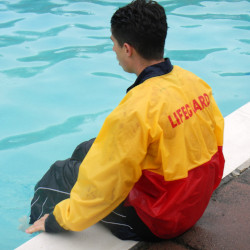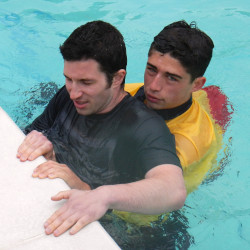Scanning the Pool
Purpose: To improve the lifeguard's scanning ability.
Description: The class is broken up into teams of 2 or 3 with one team on deck at a time. The rest of the class is in the water and will change their facial expression in an obvious manner (smile), in a random pattern throughout the exercise.
The lifeguards on deck must whistle and identify the expression on the person's face. If a person is missed, they should call out that they've been missed.
A variation would be for the lifeguard to have to reach and touch the smiling person wherever they might be,
on deck or in the water.
The casualty should start counting when they begin smiling,
hold the facial expression until touched and tell the lifeguard how long it took them.
The 10:20 System
The 10:20 system is an effective technique used by lifeguards all over the world to provide good pool safety.

The first requirement is scanning the pool, or the designated area, from one side to the other in 10 seconds.

The second requirement is that a lifeguard is no more than 20 seconds away from any swimmer who may get into difficulty in the lifeguard's area.

This method lets a lifeguard quickly return the casualty to safety and provide any requisite aftercare.
Clearing the Pool
Purpose: To practice clearing the pool effectively in case of an emergency. This helps avoid further casualties and clears the scene for the rescue.
Description: A class member at one end of the pool blows one long whistle blast and clears the pool in a professional manner. The other class members are the swimmers who more or less willingly come out of the water.
Practice having the lifeguard walk quickly along the side as they clear the pool. No running is allowed as this could lead to nasty accidents.
Another variation would be to have them at opposite ends of the pool
and attempting to yell and communicate over some type of loud noise.
Emergency Procedures
Purpose: Give your lifeguards a chance to practice their signals, communication, and rotation without getting wet or doing rescues. Practice the minor and major emergency procedures without actual casualties.
Description: The class is broken up into teams of 2 or 3. Make sure you give them experience at both 2-man team and 3-man team formations.
Each team positions themselves as if they were guarding the pool. The team members, one at a time, pretend to have minor and major emergencies, and signal the appropriate signal to their team.
The other lifeguards must give recognition, cover the pool, back-up the rescuer, clear the pool, etc. The rescuer crouches to simulate their rescue.
The teams should be prompted to communicate and evaluate themselves constantly
with regards to their rotations, communication, and patrolling.
The candidates shout out every single job that they are doing as they do them,
the imaginary casualty types,
and tell each other what they are supposed to be doing.